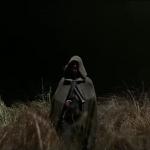
Astrid Bergès-Frisbey in King Arthur: Legend of the Sword, photo courtesy Warner Bros.
Men and Mages
Ritchie gives us a quick political primer on his version of ancient Britain at the opening bell. “For centuries,” we’re told, “man and mage lived beside each other in peace.” Or they did, until an evil mage named Mordred decided to conjure up those titanic elephants and declare war on mankind.
Wholly imaginary, right? Well, yes. And no.
King Arthur was allegedly a home-grown king in a post-Roman Britain. He lived around the fifth or sixth century, when paganism and Christianity were both likely powerful influences on the island. While Arthur himself is unquestionably a Christian hero, some scholars point to lots of pagan influences in his story. Some believe that Arthur’s famed wizard, Merlin, was a druid. (Legend has it that he built Stonehenge, too).
So, when you look at the clash between “mage and man” even in this Ritchie rendering, you can see reflections of a struggle between two belief systems fighting for the soul of the kingdom.
But things aren’t so black-and-white. The mages aren’t the bad guys in the film: They just had a bad ruler. Arthur and his mates leverage magic plenty. A mage who can control animals (very much in keeping with the spirit of the ancient druids) is instrumental in Arthur’s hero journey. Her magic—while certainly discomforting—proves indispensable. Even Arthur’s sword, Excalibur, is inherently magic, fashioned as it was from a mage’s staff.
This blending of worlds is something that very much happened in real life, too. Sure, Christianity became the faith in Britain, and indeed the Western World. But in doing so, it co-opted plenty of pagan elements, too: Days of the week are named after Roman and Norse gods, holidays like Christmas and Easter are Christianized versions of pagan festivals.
But even though Arthur and his pals use magic, it’s never comfortable. Even Excalibur exacts a price.
It’s interesting that some of Arthur’s most helpful magical allies happen to be snakes: Very biblical, that. And while the snake is used as a symbol for evil from literally the beginning (in the Garden of Eden) to the end (in Revelations, when Satan’s referred to “that ancient serpent”), I’m also reminded of Moses’ famous “magic” tricks done with his snake-staff in Pharaoh’s court. He even fashioned a “bronze snake and put it on a pole” that saved people from snakebite.
Remember Moses, by the way. He’ll come up again.













